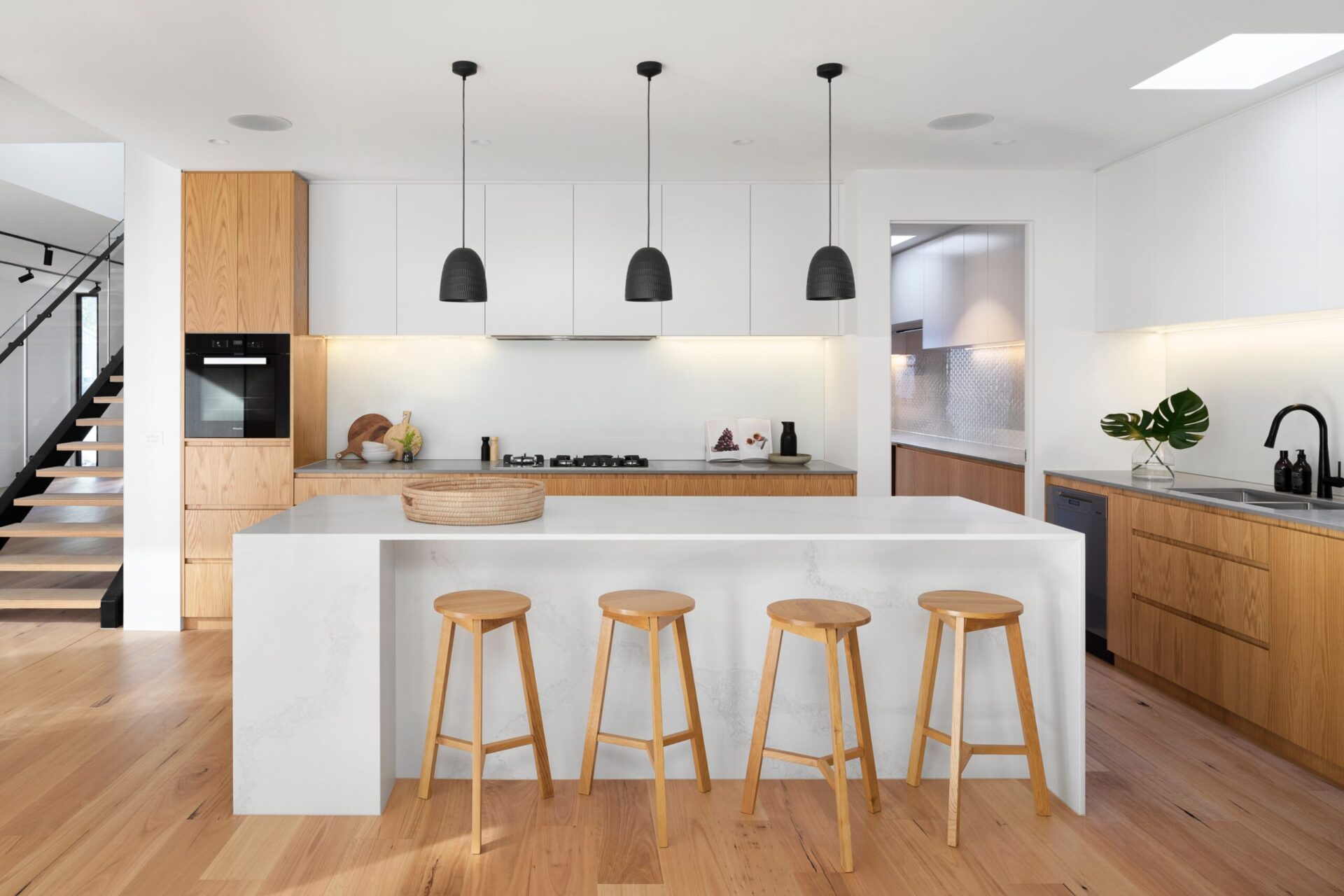Uniting Function with Elegance
The kitchen is the heart of the home, pulsating with life and activity. In modern home design, a kitchen island isn’t just a statement piece; it’s a multi-functional centerpiece that can make all the difference in your culinary and social experiences. Seamlessly integrating a kitchen island into your space requires a balance of design finesse and functional savvy. It’s about creating a harmonious space where you can cook, entertain, and live life to the fullest. This guide will walk you through the key steps to incorporating a kitchen island that is both a natural extension of your kitchen and a standout feature of your home.
Understanding Kitchen Dynamics: The Functional Triangle
The Work Triangle Essentials
The concept of the work triangle is a time-tested principle that promotes efficiency in the kitchen. The points of the triangle are the refrigerator, the sink, and the stove – the three kitchen zones you use the most. When integrating a kitchen island, it’s vital to place it in a way that complements this triangle, rather than obstructing it. This means considering the island’s position relative to these points to ensure a flow of movement that will make preparing and cooking as effortless as possible.
Designing Your Island: Size, Shape, and Functionality
Tailoring to Your Taste and Tasks
Designing your kitchen island starts with a clear vision of what you need it to be. This could range from a simple prep area to a full-fledged cooking station complete with built-in appliances. Size and shape will largely depend on the dimensions of your kitchen – a galley kitchen may suit a slim, elongated island, while a larger, open-plan space may accommodate a broader, square-shaped one. Consider also the height of the island, ensuring it matches your ergonomic needs, whether for chopping vegetables or perching on a bar stool.
Appliance Integration: A Harmonious Blend
Sleek and Synergetic Appliance Choices
If your kitchen island is going to house appliances, you’ll want to select these with the overall aesthetic in mind. Stainless steel appliances can give a sleek, modern look, while panel-ready options can be customized to blend seamlessly with the island’s cabinetry. Placement is also key – for instance, a wine fridge within the island might be positioned at the end for easy guest access, while a second dishwasher might be tucked away on the side closest to the sink for efficient cleanup.
The Social Kitchen: Islands as Gathering Spaces
Cultivating Conviviality
A kitchen island can be the perfect place to gather and engage with family and friends. To foster this sense of gathering, consider incorporating a breakfast bar or a tiered counter that allows for seating. This not only provides a casual dining area but also invites conversation and interaction, whether it’s over a morning coffee or while preparing a meal together.
Countertop Chronicles: Selecting the Perfect Surface
Deciding on Durability and Design
The countertop is the crowning glory of your kitchen island. Material choices abound, from the elegance of marble to the durability of granite or the contemporary feel of engineered stone like quartz. When selecting the countertop material, consider not just the look, but also the maintenance, durability, and how it complements the other surfaces in your kitchen.
Lighting Your Island: The Jewel in the Crown
Illuminating with Intent
Lighting is critical when it comes to kitchen islands. It’s not just about visibility for tasks; it’s about setting the mood and making a design statement. Pendant lights are a popular choice for islands as they can define the space and add a touch of drama. Recessed lighting can provide a more subtle, even illumination, while under-counter lights can add a warm glow and highlight the island’s architecture.
Stools and Seating: Where Comfort Meets Chic
Selecting the Right Seats
Comfortable and stylish seating can make your island the best seat in the house. When selecting stools or chairs, consider the height of the island’s counter and the legroom needed. Additionally, think about the style and how it complements both your island and the broader kitchen aesthetic. From industrial metal to warm wood, your choices can add texture and color to the space.
Smart Storage Solutions: A Hidden Asset
Ingenious Organization Options
Effective storage solutions can make your kitchen island both beautiful and practical. Drawers with dividers for utensils, pull-out bins for waste and recycling, and shelves for cookbooks are just a few of the ways you can maximize the space within your island. Custom cabinetry can also be designed to house your specific kitchen gadgets and tools, keeping them handy but hidden.
Seamless Integration: Blending with Your Kitchen’s Style
Creating a Cohesive Look
Integrating your kitchen island into the existing style of your kitchen is crucial. This involves choosing materials and colors that either complement or thoughtfully contrast with your current kitchen design. Whether you opt for a matching look or a standout centerpiece, the goal is to achieve a sense of harmony within your kitchen space.
The Sustainable Island: Eco-friendly Choices
Green Materials and Practices
In today’s environmentally conscious world, considering sustainable options for your kitchen island is both practical and responsible. This could mean choosing recycled materials, opting for sustainably sourced wood, or installing energy-efficient appliances within the island.
Technology at Your Fingertips: Smart Kitchen Islands
Incorporating Modern Tech
Modern kitchen islands can be equipped with cutting-edge technology, from built-in charging stations for your devices to smart appliances that can be controlled via your smartphone. These features not only enhance the functionality of your kitchen island but also bring it firmly into the 21st century.
Installation Insights: Professional vs. DIY
Understanding the Pros and Cons
Deciding between professional installation and a DIY approach is a significant step. While hiring professionals can be more costly, it often guarantees a level of expertise and finish that might be challenging to achieve on your own. On the other hand, a DIY project can be more budget-friendly and offer a sense of personal achievement.
Accessibility and Mobility: Designing for Everyone
Inclusive Design Principles
An often-overlooked aspect of kitchen island design is accessibility. Considerations like the height of countertops for wheelchair users or storage accessible from a seated position can make your kitchen island more inclusive and user-friendly for everyone.
Maintenance and Upkeep: Long-lasting Beauty
Easy-to-Maintain Surfaces and Structures
Your kitchen island will be a hub of activity, so choosing materials and finishes that are easy to clean and maintain is essential. This section of the article would explore the best practices for keeping your island looking as good as new for years to come.
Conclusion: Your Perfect Kitchen Island Awaits
Incorporating a kitchen island into your space is more than just a design choice; it’s about creating a functional, welcoming, and aesthetically pleasing focal point in your home. By considering factors such as placement, materials, functionality, and style, you can ensure that your kitchen island not only complements your space but also enhances your home’s overall ambiance and utility.
FAQs
- What is the ideal size for a kitchen island in a medium-sized kitchen? The ideal size for a kitchen island in a medium-sized kitchen typically ranges between 40 to 60 inches long and 20 to 40 inches wide. However, the final dimensions should be based on your specific space and needs.
- Can I install a sink or cooktop on my kitchen island? Absolutely, you can install a sink or cooktop on your kitchen island. It’s a great way to add functionality, but be sure to consider the additional plumbing or electrical requirements.
- How high should the seating area be on a kitchen island? For comfortable seating at a kitchen island, plan for a countertop height of around 42 inches for bar stools and 36 inches for regular chairs.
- Is it possible to add an island to a small kitchen? Yes, adding an island to a small kitchen is possible. Opt for a slim, compact design or a movable island that can be tucked away when not in use.
- How do I choose the right countertop material for my kitchen island? Choose a countertop material based on factors like durability, maintenance, aesthetics, and budget. Popular choices include granite, quartz, marble, and butcher block.


